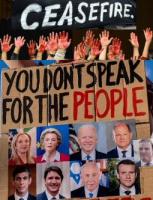You are only seeing posts authors requested be public.
Register and Login to participate in discussions with colleagues.
Canadian News
Liveblog replay: Golden Knights beat Canadiens 6-2 on Saturday night
Sam Montembeault gets the nod in goal for the Canadiens against the Vegas Golden Knights at the Bell Centre on Saturday night. Read More
Categories: Canadian News
'There are limits to civil disobedience': Palais under lockdown in aftermath of NATO protest
Windows were boarded up, police tape blocked several entrances and there was a heavy presence of private security guards and police officers at the Palais des congrés on Saturday. Read More
Categories: Canadian News
Laval Rouge et Or win Vanier Cup with 22-17 victory over Wilfrid Laurier
KINGSTON, Ont. — Arnaud Desjardins had 320 passing yards and Felipe Forteza booted six field goals to lead the Laval Rouge et Or to a 22-17 victory over the Wilfrid Laurier Golden Hawks in the Vanier Cup on Saturday. Read More
Categories: Canadian News
Trudeau, politicians denounce 'violent mobs,' 'chaos' at anti-NATO protest in Montreal
Prime Minister Justin Trudeau and politicians of all stripes are condemning the violence that broke out as part of an anti-NATO protest in downtown Montreal late Friday. Read More
Categories: Canadian News
Canadiens prospect Jacob Fowler earns fourth shutout of season
Canadiens goalie prospect Jacob Fowler stopped all 28 shots he faced Friday night as Boston College beat Northeastern 3-0 in Chestnut Hill, Mass. Read More
Categories: Canadian News
Does Rafaël Harvey-Pinard have a future with the Habs? | HI/O Bonus
That's the question answered on this Hockey Inside/Out bonus episode as former Canadiens teammates Chris Nilan and Rick Green, who were part of Montreal's 1986 Stanley Cup team, join The Gazette's Stu Cowan. Read More
Categories: Canadian News
How Le Chaînon's meal in a box is changing women's lives
At the height of the coronavirus pandemic, the 2021 annual report of Le Chaînon, a venerable Montreal organization which has been helping women in difficulty for nearly a century, said that residents of one of its buildings were hungry. Read More
Categories: Canadian News
Josh Freed: It's time to build a great wall of ice (and keep Canada nice)
Which of the following expresses your feelings about the U.S. election: a) elated; b) defeated; c) depleted; d) nauseated? Read More
Categories: Canadian News
Stu's Slapshots: Why isn't Lane Hutson on Canadiens' first PP unit?
The question I hear most from Canadiens fans this season is: "Why isn't Lane Hutson on the first power-play unit?" Read More
Categories: Canadian News
Montreal weather: Wet and windy
Mainly cloudy with a 40-per-cent chance of showers early in the morning. Read More
Categories: Canadian News
Opinion: Release the names of alleged Nazi war criminals in Canada
The moments of international justice that followed the Holocaust, from Nuremberg to the Eichmann trial, sent a powerful message about the world’s duty to genocide survivors and the consequences that awaited the perpetrators. Did that message make it to Canadian shores? Read More
Categories: Canadian News
Christmas Fund: Single mother from Ukraine makes holidays brighter for son
As it stands, it's unclear what the future holds for Katrina and her 10-year-old son: Will they stay in Canada permanently, or head home to Ukraine once the war ends? Read More
Categories: Canadian News
Cars burned, windows smashed at pro-Palestinian, anti-NATO demonstration in Montreal
Three people were arrested after pro-Palestinian, anti-NATO protesters smashed windows, clashed with police officers, and set vehicles ablaze on Friday evening. Read More
Categories: Canadian News
Guy Laliberté's Outremont mansion on the market for $12.75 million
Guy Laliberté is selling his Outremont mansion at a reduced price, though that likely won’t help the average buyer much. The Cirque du Soleil co-founder's 50-room Montreal pied-à-terre is on the market for a cool $12.75 million, down from the original price of $13.88 million when it went up for sale in October 2023. Read More
Categories: Canadian News
Grant-Mentis scores twice as Victoire beat Charge in PWHL pre-season
Before jumping on the ice at the Verdun Auditorium on Friday afternoon, Mikyla Grant-Mentis, by her own admission, had forgotten that she was playing against her former team. Read More
Categories: Canadian News
N.D.G.'s old Empress theatre to be sold for mixed-use development, city says
The next role for the decaying former Empress theatre will be as a real estate project. Read More
Categories: Canadian News
Santé Québec considering "a selective reduction of services" to cut costs: source
Santé Québec is contemplating, as a last resort, "a selective reduction of services" to the population in a four-phase plan to slash $1.5 billion in spending within the province's beleaguered health network, The Gazette can reveal. Read More
Categories: Canadian News
Laval lines up against high-powered Laurier side Saturday in Vanier Cup
KINGSTON, Ont. — Wilfrid Laurier Golden Hawks head coach Michael Faulds feels his team plays its best football when the competition is tough. Read More
Categories: Canadian News
Quebec Pension Plan benefits to increase 2.6% in January
Several Quebec pensions will increase by 2.6 per cent starting in January, Retraite Québec announced Friday. Read More
Categories: Canadian News
Quebec condemns Nazi reference at pro-Palestinian protest in Montreal
The office of Quebec's public security minister has condemned remarks made during a pro-Palestinian protest in Montreal after a masked demonstrator appeared to use Nazi terminology directed at pro-Israel counter-protesters. Read More
Categories: Canadian News




